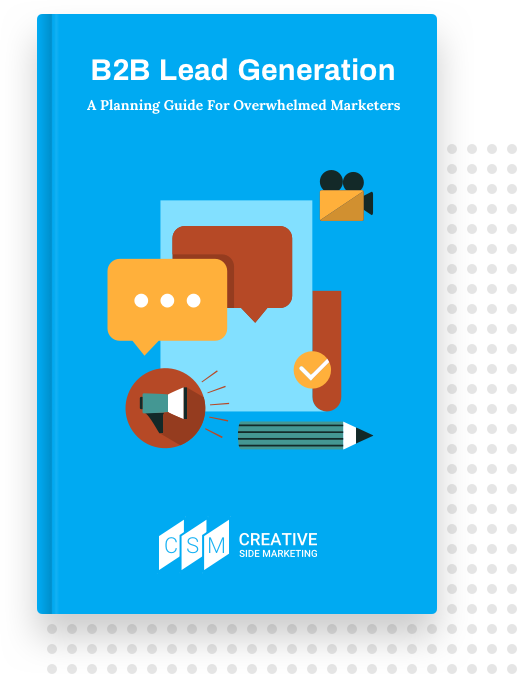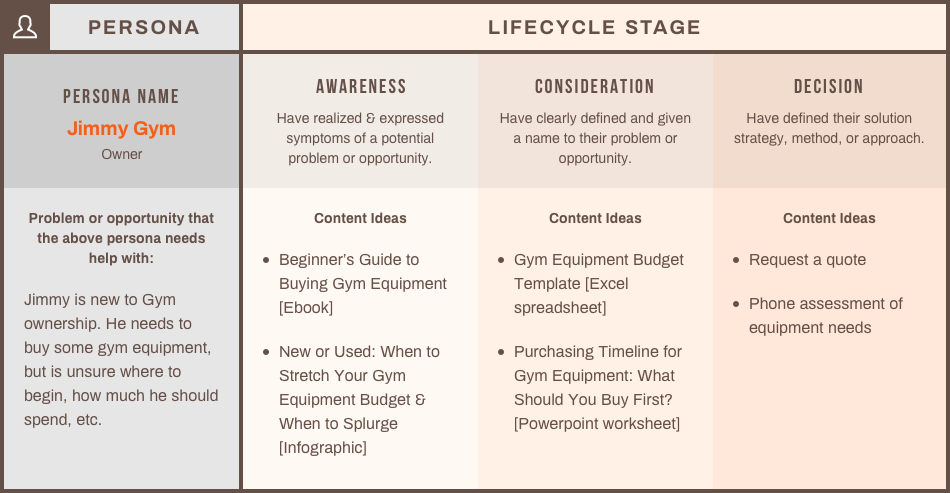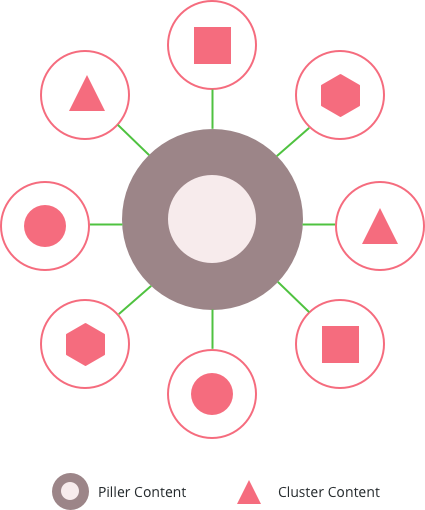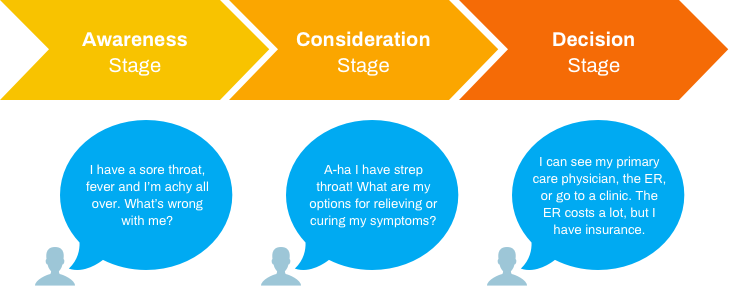B2B lead generation strategy
A planning guide for the overwhelmed marketer.
Are you trying to achieve 15-20% growth for your business, and feeling overwhelmed by the tasks to get there?
You are not alone. Some of the most experienced and capable marketers we know have felt this way. They felt like they were doing all the right things, but never saw the results they were looking for. Why is that? The answers are usually found in the planning stage.
This guide will help you learn how to plan a better B2B lead generation strategy using inbound and outbound marketing tactics. You will learn:
- How to find the path of least competitive resistance
- How to gain better insights about how your customers make decisions
- Apply those insights into a content strategy that attracts leads
We will also highlight critical steps marketers often get wrong, as well as “new” tactics for lead generation, like pillar pages and chatbots.
This guide is for you if:
- You are creating content to generate leads, and are frustrated by the lack of ROI.
- You are attracting the wrong visitors to your website.
- You are willing to embrace a different mindset when it comes to selling, based on transparency and teaching.
This guide is likely not for you if:
- You are looking for advertising tips (a different topic for another time).
- You are more worried about competitors seeing your "secret sauce" than you are about gaining new customers.
Scroll down to read the guide without having to fill out the form.
You can also fill out the form for a downloadable PDF version of the guide you can reference later.
No time to read now?
Complete the form to download a PDF version you can read later.

Creative Side Marketing needs the information you provide to share information and offer a you a productive experience. For information on how to update your subscription preferences, as well as our privacy practices, check out our Privacy Policy.
Table of contents
Click on any chapter to scroll directly
Chapter one
Competitive Analysis In Marketing
You can’t put together a productive lead generation strategy without knowing the competitive landscape, especially when it comes to Google.
In most cases we’ve seen, organic search is the highest performing channel for lead generation. Publishing high quality, well-optimized blog content on a regular basis can drastically boost your inbound leads, but first you need a competitive analysis to help you understand how how much resistance you will face in your campaign.
1. Examine Search Engine Results
Try searching for your ”core product or service” and “blog,” and see the number of results that come up. Sometimes a small variation in the phrasing can have a big impact on results. See a comparison below we did for a client recently:

Now look at this one:

Notice how the results went from almost 1.1 million results to about 9,100, just by changing the query focus to “luxury product packaging?”
So what does this information tell us?
In his book,The Content Code , Mark Schaefer, advises us to look to analytics expert Christopher Penn for insights. Penn has created a tiered system for classifying content saturation that goes something like this:
Less than 10,000 results – This niche is wide open for your brand to claim.
10,000 to 100,000 results – You will run into some barriers while trying to get your content noticed, although you can likely beat them by producing amazing content on a consistent basis.
100,000 to 1 million results – You’ve got a tough road ahead. Producing great content is mandatory, and you will need a smart promotional strategy to get real traction with buyers.
More than 1 million results – This niche has been crushed. You will have to make a significant investment of money and resources, or a very good promotional strategy, if you want any chance of making a dent with an audience.
These are rough numbers, but they offer a baseline to determine what you are up against. For more exact numbers, Schaefer names Sysomos as a great research tool for analyzing trends.
2. Compare Content Saturation With Demand.
Next you need to compare content saturation with actual demand.
Referring back the example about “packaging solutions,” our client might find there are hundreds or thousands of searches a month for “luxury product packaging” and a relatively low saturation score on Google results.
This could be an opportunity, but we need to dig deeper.
3. What is the Difficulty For Ranking?
Try doing a few Google searches to see who is ranking for your target phrases and compare their domain authority to yours.
Domain authority is a score given by Moz that predicts the strength of a website in search engine results. You also need a “difficulty tool” that scores each phrase on how hard it is to rank for that term. Paid marketing platforms like Moz, SEM Rush, and a few others offer this.
Look for core topics that are:
- Relevant to your services
- Getting high search volume
- Have a low difficulty score (0-50)
Look for opportunities your competitors have left open. You may find a niche that’s ripe for domination, or a market segment your competitors have neglected.
4. Pay-Per-Click Advertising on Google AdWords
Organic search is not the only way to attract new prospects on Google, of course.
A pay-per-click (PPC) campaign can help you start getting results overnight, but it pays to know what your competition is doing before setting up your campaign.
Tools like Auction Insights enable you to compare your campaign performance with other advertisers targeting the same keywords your are. This gives you insight into how to improve your budget, bidding strategy, and quality score.
Likewise, SEMRush and SpyFu are tools that allow you to analyze specific competitors. By submitting their domain name, you can gather insights into their average position in paid search rankings and the approximate budget they are allocating to those keywords.
Learn more about best practices by checking out PPC Hero. They know their stuff.
Chapter two
SMARTer Marketing Objectives
Even though most businesses claim to set marketing goals, very few of them do it in a way that makes it useful to the campaign.
A good goal looks like this:
“Our goal is earn $2 million in new revenue next year. We will do this by getting 50,000 visitors, 1000 leads, and 20 customers.”
We know exactly how far we have to go to reach our goal, and the steps we need to accomplish to get there.
This eliminates any vagaries and gives us a clear direction to go in.
Let’s say your business did $5 million in sales last year, and you want to bump that up 30% to $6.5 million.
Our first job is figuring out how much of that gap do you expect to close by doing nothing different than last year. Maybe your sales team is projecting an additional $200,000 in the next fiscal year.
That leaves a gap of $1.3 million you need to make up. We now have our goal.
Goal = $1.3 million
Now it’s time to work backwards, and reverse-engineer our marketing plan.
How Many New Customers Do You Need?
Find out what your average customer spends in a year and divide it into your overall goal. If the average spend is $50,000 a year, you will need 26 new customers.
How Many Leads?
A lead is a person who has visited your website and taken at least one step into your sales funnel by converting on one of your offers.
It's important to note that not all leads are good ones. Through the nurturing process, you will qualify leads that are likely to buy as marketing qualified leads (MQLs). MQLs that are identified as a good prospect by your sales team will become sales qualified leads (SQLs), and then, opportunities.
We do this labeling to identify not only the quality of the lead, but also the stage of the buyer's journey he or she is in.
Your lead-to-customer metrics will depend on how successful you are at aligning your content strategy with the needs of your buyers. For now, assume roughly 3% of your leads will become customers.In this case, we will need roughly 925 leads to close 26 new accounts that spend $50,000 a year.
How Many Visitors?
Most inbound marketing campaigns average around a 2.5% visitor-to-lead conversion rate. This number should improve as time goes on, but to start with, aim for 37,000 visits to achieve your goals.
Based on our calculations, you will need 37,000 visitors a year to deliver 26 new customers worth $50,000 a year. This will achieve our goal of $1.3 million in new revenue.
Don’t expect these numbers to work out perfectly!
Don’t spend hours trying to create a perfectly accurate analysis.
Our purpose is to create a roadmap that sales and marketing can follow as they carry your brand to success! Break up these benchmarks into monthly and quarterly targets. Review them as you go, and make adjustments as needed.
Chapter three
Buyer Personas
A buyer persona, as defined by HubSpot, is a semi-fictional representation of your ideal customer based on research and information about your existing customers.
Businesses often align their content with generic buyer profiles that have little or no bearing on how people actually research and buy a solution.
They are building their messaging on a foundation that doesn’t really exist. This is one of the biggest reasons why B2B lead generation campaigns fail.
The best way to get useful insights is by interviewing 8 to 12 people who have researched and purchased a product or service like yours.
Some of them could be customers. Others might have chosen a competitor.
Once you’ve scheduled the interview, you need to prepare the questioning that will get you the answers you need. We follow the methodology created by Adele Revella of the Buyer Persona Institute to get the 5 Rings of Buying Insight:
What changed within the organization that made finding this solution a priority?
How did they begin the search, and what did they find that influenced the decision?
What results did they hope to achieve with this solution?
Why would they not consider your product or service as the best option?
Who else was involved in the decision making and what were their priorities?
For a few examples, check out our article, "Buyer Persona Examples That Will Change Your Marketing," or learn from the master herself and read “Buyer Personas” by Adele Revella.
Chapter 4
Content Strategy
Now that your marketing goals and buyer personas are set, it’s time to figure out how you are going to attract and convert new customers with your content. Using these insights we have gathered, we can start to piece together a content strategy that meets their needs at every step of the “buyer’s journey.”
The three main stages of the buyer’s journey are Awareness, Consideration, and Decision.
During the awareness stage, a person experiences a challenge or opportunity that requires research to solve. This stage is usually characterized by a search for basic information about the problem, and how to solve it.
At the consideration stage, the person has given a name to this particular challenge or opportunity, and is now looking for broader solutions.
Upon reaching the decision stage, the prospect has decided on the solution required, and is researching and comparing vendors who can provide it.
Our job is to compile a create a list of content topics and types that will assist our persona at each stage of the process.

Use HubSpot’s Content Mapping Template to keep your content aligned with a specific challenge or opportunity your buyer persona has.
Use the columns to plan topics and content types that will help you attract people and convert them at each lifecycle stage of the journey.
Chapter number 5
PIllar Pages & Topic Clusters
This chapter is all about how search engine optimization (SEO) is changing.
There was a time not long ago that people searched for information using simple phrases. Those searches delivered useful information because there weren’t many publishers on the web.
Things are different today.
People are much more deliberate with their queries, using long phrases and questions to find what they are looking for. Google’s algorithms are also getting smarter, using context and user intent to deliver superior results.
Brands need to make their content easy for search engines to find and index, while delivering outstanding information to people.
What Are Pillar Pages & Topic Clusters?
Topic clusters are a somewhat new way of organizing blog content. Instead of focusing on keywords, you build your content hierarchy around topics.
Pillar pages are core topics your topic clusters relate (and link) to. Like pillars on a massive edifice, these pages provide support to your content architecture, offering a comprehensive overview of the core topic.
This guide you are reading right now is a pillar page about “B2B lead generation,” and every relevant subtopic we blog about is part of the topic cluster linking to it.
Think of a pillar page as an in-depth ebook or a whitepaper that’s free and accessible on your website.
Rather than formatting the content as a pdf (which Google can’t read) and gating it behind a landing page, you publish it for all the world to see, and link all relevant blog posts to it.
What are the Benefits?
Through extensive research and testing, HubSpot has determined that organizing your content like this can boost SEO rankings, sometimes on a massive scale. You are basically creating 10x content that’s easy for search engines and visitors to access and navigate.
Will It Generate Leads If My Content Is Not Gated?
It still makes sense to gate offers on your website, but your long form content will likely serve a greater purpose as a pillar page.
You can still generate leads from it by offering people the option of downloading the pdf for reading later on. Research shows that people would rather save and read a pdf at their leisure, but at least you’ve given them a taste of the great information inside by sharing all the content on your site.

Chapter number 6
Lead Generation Offers
By now your campaign should be slowly coming into focus. It’s time to plot out premium content offers that will convert leads at the Attraction, Consideration, and Decision lifecycle stages.
Years ago, when inbound marketing starting to catch fire, you could write up an whitepaper or ebook, lock it up behind a landing page form, and watch leads roll in.
As more marketers started using this tactic though, people started getting frustrated about having to give up their email or phone number to access the content they want. As a result, the effectiveness of these offers has declined. The average conversion rate is now closer to 2% or less for whitepaper or ebook offers.
So, how can you plan a better lead generation strategy that works?
1. Pillar Page PDFs
As mentioned earlier, your pillar page provides structure and support for the core topics your customers are seeking information about. These core topics should also be directly related to your brand’s most important products or services.
As people visit your pillar page, chances are good they won’t have time to read it all in one sitting. Offer them the opportunity to download a pdf in several places on the page.
2. Online Courses
A comprehensive online course can be a powerful lead generation offer. You could pre-produce a video or printed tutorial, or schedule a live webinar series that helps people advance their professional goals.
By giving them exclusive access you can create scarcity and value that’s enticing to visitors.
Just make sure the value is there.
Nothing is worse than signing up for a course that falls way short of what you were expecting. Make sure you communicate exactly what people will learn, then deliver.
3. Demos & Trial Offers
Free demos and trials are great conversion offers for “freemium” services like SaaS.
People often want to take a test drive with products to see if it fits their needs. Once they opt-in for a free trail, you can nurture your leads by sending them tips on how to use your tools better, while also wetting their appetite for enhanced features included in a paid solution.
4. Interactive Tools
Have you ever used a mortgage calculator or a similar app while researching a purchase? Interactive tools can help your visitors solve a challenge, while also drawing them into your sales funnel.
For example, many website visitors won’t opt for a “free assessment” because they don’t want to talk to a sales person.
Give them an option to do a self-guided assessment online. You can collect data about the prospect’s needs, and follow up with insights to have a better quality conversation.
In other words, you are nurturing a relationship with the customer on their terms, building trust and warming them to the idea of working with you.
5. Market Research
Businesses are more data-driven than ever, and industry research and reports are a big draw.
If your organization has the resources to do market research customers would find valuable, you’ve got a powerful and unique offer for capturing leads.
This type of content can be expensive to produce, but very effective. You should also plan on updating the research periodically, making sure it stays current with customer needs and industry trends.
6. Templates
Templates make great content offers because they are easy to produce and people love them.
You can create templates for just about any purpose that helps people accomplish a task. Maybe your prospects need a planning calendar, or a worksheet for outlining a business process.
When a template helps your buyer personas in the awareness and consideration stages, you have a great opportunity to guide them to the next stages – decision and close!
7. Checklists
Like templates, checklists are another great example of short-form content offers that generate leads.
Checklists are best when they’re brief, focusing on the most important aspects of a given topic. Dress it up with a nice design, focusing the user’s attention on key points.
8. Chatbots
Chatbots are all the rage in marketing today. Although still in the experimental stage, chatbots can help you accelerate the process of gaining valuable insights about a prospect through short interactions.
Apps like Chatfuel and ManyChat are two of the most popular bots you can build using the Facebook Messenger platform. Others like Drift allow you to run the bot on your website.
My friend Dana Tran is a chatbot master who can teach you a lot about how to use this amazing tool. She offers an amazing online course on Bot Essentials through her company, Thinktuitive.
Chapter number 7
Outbound vs. Inbound Marketing
By now, you’ve got a clear picture of how inbound marketing is key to aligning your lead generation strategy with the way people want to buy.
By putting helpful content in their hands, you give them the resources they need to make an informed decision, and while this is the vital part of a B2B strategy.
But it is not enough.
As the content universe gets increasingly crowded, it’s gotten more difficult to “rise above the noise” and get your brand noticed. This is why we also recommend using outbound marketing tactics with “an inbound attitude.” What does that mean exactly?
Outbound marketing is where the brand initiates contact with the customer. This includes tactics like advertising and direct selling. Outbound is interruptive marketing, which is not much in vogue these days.
Here are ways you can leverage the best that inbound and outbound have to offer your customers:
Write your posts and shoot your videos (inbound), then amplify it with paid promotion (outbound).
Share best practices in your content (inbound), then get your sales people to start every “warm call” to prospects with these tips (outbound).
If you are using traditional advertising (outbound), focus on customer needs and help them without selling (inbound).
If we have to interrupt people with outreach of any kind, we need to make sure it’s personalized, helpful, and respects the culture behind the platform as much as possible.
Chapter number 8
Analyze, Test, & Repeat
Now that your campaign is underway, keep a close eye on your campaign metrics and monitor your KPIs.
Remember the benchmarks we established in the Goal Setting phase? These are the numbers you need to watch as you start drawing people into your pipeline.
Do not expect things to be perfect! Success with lead generation is a process that involves constant testing, learning, and optimization.
Even if you are able to devise an amazing strategy right out of the gate, it likely won’t be amazing for long.
Customer needs change, new tactics emerge, and your brand will need to adjust.
As long as you know your customers and keep your strategy aligned with how and when they want to buy, you will never struggle to grow.
Need Help With Your Growth Strategy?
Schedule an exploratory call with one of our experts.
Creative Side Marketing needs the information you provide to share information and offer a you a productive experience. For information on how to update your subscription preferences, as well as our privacy practices, check out our Privacy Policy.
